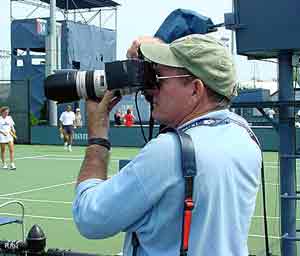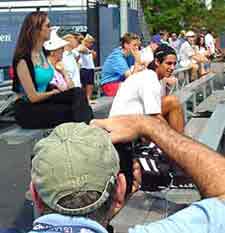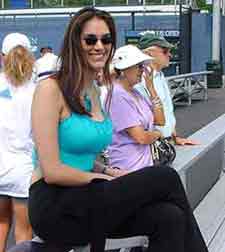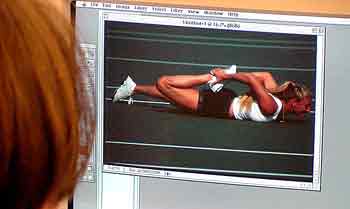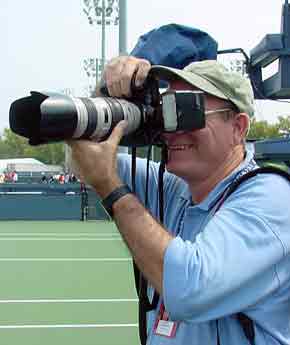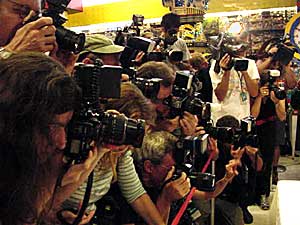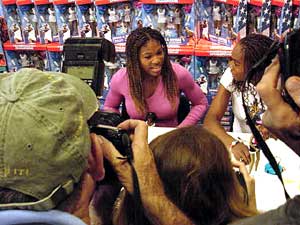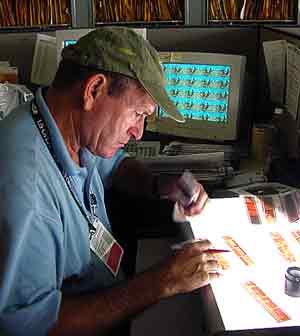<% ns_puts [mkm_getnavbar] %>
Art Seitz is a Combat Artist
by John Martin
Copyright 2001
Photos by John Martin (Courtesy ABC News), and Art Seitz.
|
Photographer Art Seitz is a combat artist. He scrambles over barricades, squeezes into courtside portals, peers out of press box windows, and scurries into closing doorways to capture startling, drop-dead, head-turning images of the world's finest tennis players.
For 30 years, he's been to every major battlefield: from Wimbledon to Paris to Flushing Meadows to Sydney, and to most of the famous skirmish lines in between.
Dressed in khaki shorts or chinos, wrapped in straps and armed with two or three cameras, Seitz wages daily struggles to gain deep penetration of enemy territory: the courtyards and locker rooms and roped-off citadels of players who operate behind a cordon of coaches, agents, friends, officials, and public relations gatekeepers.
His mission is simple: Get a great picture and sell it to the world. But talk to the fifty-something freelancer from Fort Lauderdale, FL for only a few minutes and you realize he is an embattled gladiator.
"They're $20,000-a-year sycophants," he snarls, laying out a tale of frustration with tournament officials who refuse to carry simple requests for access to players. As any lexicographer can tell you, his anger is reserved for what the dictionary defines as "a servile, self-seeking flatterer."
"They run if there's a frown," he growls, quoting a former Life Magazine photographer friend's appraisal of tournament public relations officials at a recent major tournament.
|
|
"I spent $15,000 to go to Lisbon for the (year-ending) Tennis Masters Cup and all I got was rhetoric," he complained recently.
With a typical attention to detail and an eye on fashion and history, Seitz had arranged with a Portuguese national museum to lend authentic costumes for a photo session with the top players.
"The museum said 'when?' and 'for whom?'", says Seitz, indicating its officials offered their complete cooperation. "The ATP didn't follow through."
Instead, he says, "We got Andre Agassi signing photographs of himself in bad light."
It wasn't the first time a Seitz picture idea with more than a little verve went begging. In Florida earlier this year, Seitz says he convinced the Del Ray Beach police to agree to enroll Patrick Rafter as an honorary member. The idea was to hand the Aussie scrambler a rifle and to pose him with the city's SWAT team on a "mission" to capture the tournament.
Even though the players are "obligated to give the tournaments two hours of their time," Seitz says, "they don't show."
Rafter didn't show. "He went bungee jumping in Germany," Seitz says, by way of arguing that given the right signal by agents and tournament officials, players are more than willing to cooperate with photographers.
For Seitz, the cooperation isn't nearly enough to permit the sport of tennis to break out of its country-club, daisy-gazing image. It's also a struggle for photographers to make a living, he says, shooting only staged photos with sponsors and opponents.
To be sure, Seitz has his critics. Assistant USTA Media Director Bruce Levy dismisses Seitz's complaints as unfounded, suggesting the former University of Florida tennis letterman is overly aggressive and under appreciative of the access he is given.
Levy said he was forced to lift Seitz's press credential and expel him from the U.S. Open one year. The infraction: breaking rules on access. Seitz replies that he committed no infractions and that players gladly had their photos taken by him and even sided with him in the dispute.
|
At the U.S. Open last summer, both Seitz and the USTA seemed on their best behavior, perhaps aware of possible tension and striving to avoid a bust-out collision.
Seitz did seem engaged but restrained. As I watched from the sidelines and followed him for a day, here's how he operated: Standing at the edge of a grounds court at Flushing Meadows, Seitz moved toward the net, his body rotating gracefully as he raised his arms and turned to make a shot, a half smile on his lips.
Spotting Mary Pierce stretching on a distant court, he wheeled and turned to make a shot. Click. Click. Then he turned back to the practice session at hand: Nicholas Lapentti of Ecuador was stroking backhands, wearing black shorts, white T-shirt, and black cap turned backward. Watching him was an attractive woman in white pants and turquoise halter.
"Didn't I photograph you in the Miss World contest in 1998?" Seitz asked with a twinkle. She burst into a smile. Click. Click. How does he get unusual pictures?
"I'm intuitive," he says, "I notice things in people. The quality of the light, the patterns of things."
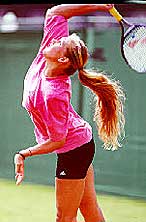 |
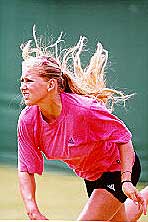 |
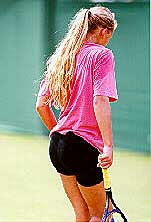 |
Seitz focuses on the way the sunlight plays with Anna Kournikova's hair |
||
His triptych of Russian teenage phenomenon Anna Kournikova is an example: It captures a bronzed female whose long blonde hair flounces up in the sunlight, then plunges and angles downward in counterpoint to her movement in hitting a serve, then comes to rest as she walks ramrod straight, moving away from a point.
Three shots of Carlos Moya of Spain announce a dancer. Shirtless Andre Agassi reveals a furious forehand.
And John McEnroe reaches out, his arms and legs headed in four directions, a white bird stretched across red clay.
Seitz is not modest about his talent ("I was one of only two photographers invited to Fred Perry's memorial service," he says, adding that it was as a mourner rather than as a photographer that he was asked to attend.
Despite a certain bravado, he is modest about his accomplishments: "I get a lot of pleasure from the camaraderie, the characters" he said. "I've got lots of pictures that wind up on somebody's icebox door. There are very few people in tennis I haven't given pictures to."
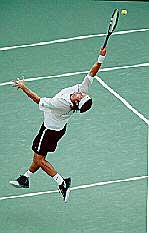 |
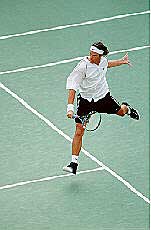 |
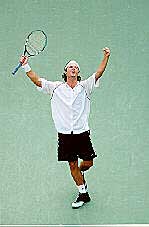 |
Carlos Moya of Spain captured as a dancer on the court. |
||
Players showed they recognized him, smiling in his direction or shaking his hand as they entered the grounds of the National Tennis Center, intent on practice, practice, practice.
"I approached six players and didn't get a single flat turndown," he said proudly. In a sport where young egos are constantly stroked and the art of self-possession is practiced by a silent majority, this is an achievement.
At one side of a court where Kournikova was practicing, he coaxed a young woman player into skipping rope. It was early in the week and Seitz was only revving up his engine.
Already, he was upset. A young USTA tournament aide had banned photographers from the sidelines of the practice courts where Kournikova and others were stroking forehands in front of an appreciative gaggle of fans. All were reduced to peering through the metal fence.
|
Seitz still managed to take a lot of pictures. In just the first two days of the event, including some qualifying matches, he shot 56 rolls of film, delivering them to a photo lab on the grounds of the Open, where they are processed for free.
The manufacturer, Fujifilm, makes its money from sales of its 35mm product and earns goodwill from professional photographers for its no-charge processing service.
Each photo goes into Seitz's mental Rolodex. The Lapentti shots were to go to Latin America. Seitz services more than a dozen tennis magazines around the world. He reeled off the names: Tennis Oggi (Italy), Smash Tennis (Switzerland), Tennis (Holland), Tennis Plus (Russia).
"I had 96 photos in one issue of Tennis Match," he reported, citing the American magazine as one of his best customers.
At noon on the day before the Open officially got underway (qualifying rounds were complete), we headed for the back gate. Tucked in a clear plastic bag were 56 envelopes containing strips of film negatives. Seitz walked past the World's Fair Globe fountain and boarded a bus to a distant parking lot, where he tucked his cameras and film out of sight in his van, then took off for Manhattan.
|
Twenty minutes later, at FAO Schwartz, Seitz waded into a phalanx of photographers struggling politely for position. They were trying to shoot the picture of the moment: Venus and Serena Williams unveiling their $39.99 pair of dolls.
Small children waited for the their chance for an autograph as the dozen photographers tried to capture the sisters without revealing the weaving, sweating mass of journalists surrounding them.
Seitz moved in, dropped to one knee, and was lost in the mob.
"Hey, V, " he said softly, "Venus."
No reaction from a woman he has been photographing for a decade. Venus and Serena were locked in conversation.
"Amazing concentration they have," he said.
|
Then, almost magically, the group parted and began to thin. The shots came. Seitz had his pictures and was ready to leave.
"It's a classic case of the value of just stickin' around," he says.
Pulling out of a side street, he drove down Fifth Avenue, searching, of all things, for an Instant Photo Lab. "There's one," he said. Parking, he carried several rolls from the Williams shoot in the front door directly beside the "One-Hour Photo" sign.
The sight is delicious: Seitz, a photographer with awards and covers of Sports Illustrated, Time and Newsweek in his portfolio, plus hour-long portrait sessions with four Presidents (Ford, Carter, Reagan, and Bush), walks into a mass production photo lab.
"It's a crap shoot," he admits, "but it can come out either way: good or bad."
Then he walked out for lunch. An hour later, after scrambled eggs and steak (and briefly holding up a set of negatives for inspection in the dim restaurant light) Seitz picked up his freshly processed film and headed downtown.
|
Near the Holland Tunnel, he parked the van and entered a cavernous building under renovation on Varick Street. Upstairs, down a long, dark hallway, sat Spencer Platt, a weekend editor with Liaison, a photo agency. Seitz pulled out his negatives and conferred briefly with Platt, who was distracted, editing and transmitting the agency's daily news photos to clients around the world.
For three hours, Seitz sat at a desk, studying and marking negatives, filling dozens of boxes with slides. Occasionally, he called Platt over to examine his best shots. A young photographer with long hair and an engaging smile, Platt was preoccupied with transmitting shots of President Clinton touring Nigeria. Finally, shortly before 7 p.m., Seitz coaxed the editor into scanning and pulling a few photos of Venus and Serena Williams. They were to go out to Europe, probably too late for most newspaper deadlines on the Continent.
"I should have taken the bag directly to Kennedy (Airport)," he said, frustrated that his competitors had gotten a jump.
But Seitz was not angry. He thanked Platt and walked out into the evening. Cars and trucks are rumbled past. He headed for his midtown hotel. Tomorrow, and every day for two weeks, there were matches to shoot. For all his anguish, Art Seitz was in his element - fighting the war for great tennis pictures.
Portions of this article appeared on the ABCNews.com website.
 John
Martin, an ABC News National Correspondent, is the founder and editor of
Aztec Tennis Reporter, a worldwide newsletter for the San Diego
State tennis community.
John
Martin, an ABC News National Correspondent, is the founder and editor of
Aztec Tennis Reporter, a worldwide newsletter for the San Diego
State tennis community.
To receive the Aztec Tennis Reporter, write to John Martin, 1528 Corcoran St., NW, Washington, D.C. 20009.
Copyright 2001, John Martin
Your comments are welcome. Let us know what you about think
John Martin's article by emailing
us here at TennisONE.
Last Updated 4/1/01. To contact us, please email to: webmaster@tennisone.com
TennisONE is a registered trademark of TennisONE and SportsWeb ONE; Copyright 1995. All rights reserved.

